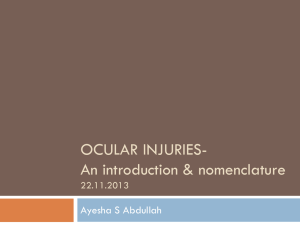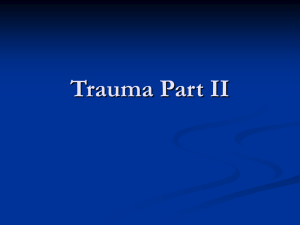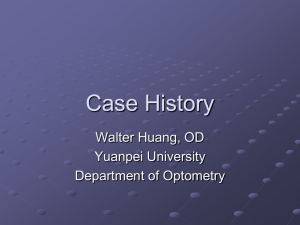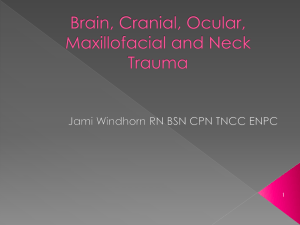Profile of ocular trauma in northern Himalayan region
advertisement
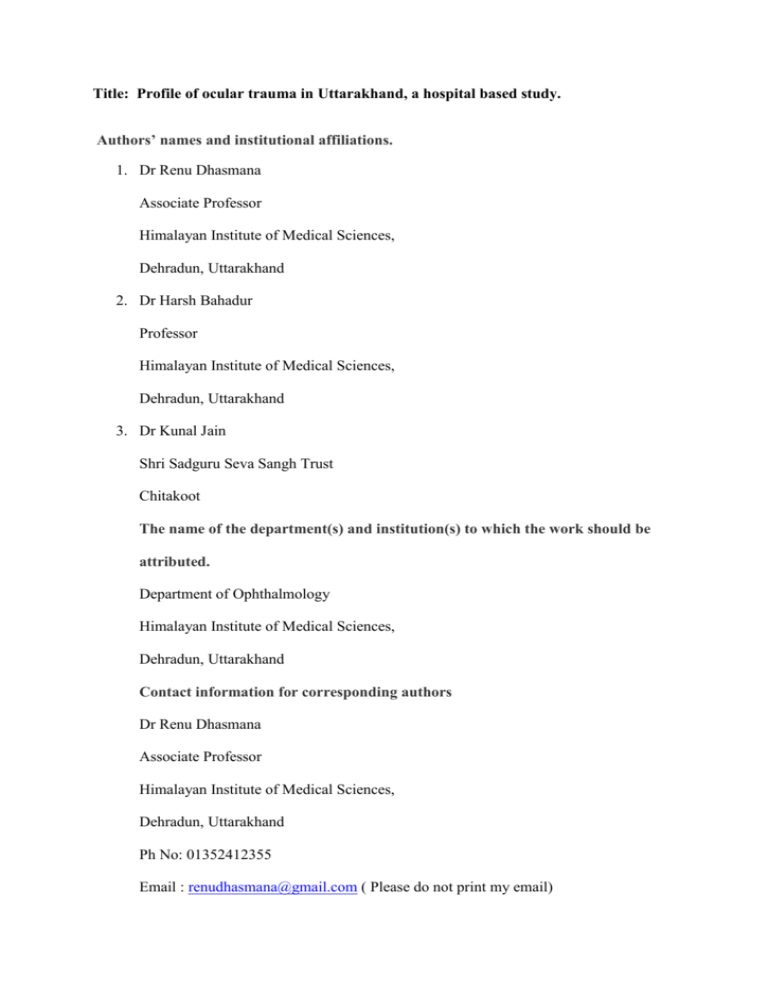
Title: Profile of ocular trauma in Uttarakhand, a hospital based study. Authors’ names and institutional affiliations. 1. Dr Renu Dhasmana Associate Professor Himalayan Institute of Medical Sciences, Dehradun, Uttarakhand 2. Dr Harsh Bahadur Professor Himalayan Institute of Medical Sciences, Dehradun, Uttarakhand 3. Dr Kunal Jain Shri Sadguru Seva Sangh Trust Chitakoot The name of the department(s) and institution(s) to which the work should be attributed. Department of Ophthalmology Himalayan Institute of Medical Sciences, Dehradun, Uttarakhand Contact information for corresponding authors Dr Renu Dhasmana Associate Professor Himalayan Institute of Medical Sciences, Dehradun, Uttarakhand Ph No: 01352412355 Email : renudhasmana@gmail.com ( Please do not print my email) Source(s) of support in the form of grants, equipment, drugs, or all of these: None Word Count: 2485 The number of figures and tables: 5 Tables and 3 Figures Conflict of Interest: None Abstract Background: Although ocular trauma is preventable public health problem throughout the world it is still one of the common causes of ophthalmic morbidity and monocular blindness. There are no published studies of pattern and severity of ocular trauma in Uttarakhand. The present study analyzes the pattern and visual outcome of ocular trauma in this region. Methods: Study design: Prospective hospital-based study. Settings: Patients of ocular trauma presenting to Department of Ophthalmology and emergency department, Himalayan Institute of Medical Sciences, Dehradun. Participants: All ocular injury patients seen for the first time during the period January 2008 to December 2008. Results: A total of 88 patients, and 103 eyes, were studied. Men had two fold higher rates of injury than women. The mean age of presentation was 31.2 years + 13.6 years (range: 6 years- 80 years). The predominant age group was between 21-40 years, 55.29 % (n = 47). Eye injuries related to road traffic accident were seen in 37.86% of eyes. Industrial workers were more frequently involved in ocular trauma (23.86%). Closed globe injuries were noted in 53.39% eyes (n=55) and open globe injuries were noted in 38.83% eyes (n=40). 7.76% eyes (n=8) were suffering from chemical injuries. The initial presenting visual acuity of the patients with blunt ocular trauma was better than penetrating injury. Eye with better visual acuity at presentation had better visual prognosis at 6 months. Conclusion: Ocular injuries were common in young males. Road traffic accident related eye injuries were noted in a significant number of cases. Strict implementation of traffic rules, health education and preventive strategies will help to decrease the occurrence of ocular injuries. Keywords: Ocular trauma, eye injury, prevention, diagnosis, visual outcome Ocular trauma is preventable public health problem throughout the world. It is one of the common causes of ophthalmic morbidity and monocular blindness in all parts of the world 1. The annual incidence of ocular trauma is around 55 million, of which 750,000 cases require hospitalization each year2. These injuries can occur in almost any setting including recreational and sports related activities, work place, home, rural agriculture setting and road traffic accidents3. Presentation of ocular trauma may be varied ranging from minor injuries like sub-conjunctival hemorrhage to perforating injuries. Epidemiology of ocular trauma has been clearly studied in developed countries but there is limited data on severity, mode and outcome from developing countries4. Epidemiological data regarding ocular trauma is also lacking from different parts of India. Varied approaches to ocular trauma analysis may help identify risk factor, plan strategies for the prevention and management of injures. The objective of current study was to analyze the risk factors, profile and visual outcome of ocular trauma occurring in Uttarakhand. Material and methods Informed consent was taken from all patients. This prospective study included all patients attending emergency or Ophthalmology Outpatient Department, sustaining eye injuries that required medical or surgical management at Himalayan Institute of Medical Sciences, Dehradun during a period of twelve months (January 2008– Dec 2008) with minimum follow period of 6 months. The Department of Ophthalmology of Himalayan Institute of Medical Sciences, Dehradun offers both emergency eye care and specialized care for patients of all ages with specific and complicated ocular diseases and serves as a referral centre in Uttarakhand region. Approval for the study was obtained from the hospital’s ethical committee. All patients were examined according to standardized protocol and data recorded in proforma developed for the purpose. Demographic data and details of the mode of injury were obtained. The patient’s initial complaint, as well as the interval between the time of injury and time of presentation, was recorded. The examination findings of the injured eye, the visual acuity, diagnostic tests, investigations and final diagnosis were obtained and recorded according to the standardized classification of ocular trauma5,6 (Fig1). The detailed ophthalmic work up of all the patients including slit lamp examination, +90D examination and indirect ophthalmoscopy was carried out. Ultrasonography was used whenever unclear media prevented fundus evaluation. Fig 1: Classification of mechanical globe injuries according to BETT classification Injury Closed Globe Contusion Lamellar Laceration Open Globe Laceration Rupture Penetrating IOFB Perforating Statistical analysis Data were analyzed with SPSS version 16.0 (SPSS, Inc., Chicago, IL, US). Frequency analysis was performed by the chi-square test. One-way analysis of variance (ANOVA) was used to evaluate differences in parametric variables. Correlation analysis for initial and final visual acuity was performed with Spearman's test. P-values less than 0.05 were considered statistically significant. Results 103 eyes of 88 patients fulfilled the inclusion criteria. The study group included 68 men (77.27%) and 30 females (34.09%). The follow up period ranged from 9 months to 27 months. The mean age of the study group was 31.2 years + 13.6 years (range: 6 years- 80 years) (Fig 2). The pediatric age group (16 years and younger) constituted 11.76% of all cases. Significantly more men were injured as compared to women in our population (P=0.001, chisquared test) with a male to female ratio of 1.93:1. Fig 2: Age and sex distribution No of patients Age and Sex Distribution 35 30 25 20 15 10 5 0 Male Female 0-20 21-40 41-60 61-80 Age in years Cause of injury and occupation of all patients was recorded (Table 1). 37.86% eyes were involved in ocular trauma during road traffic accidents. 33% of eyes suffered injury at workplace. Ocular injury at domestic setup occurred in 12.62% cases. Assault by animals particularly bears was seen in this hilly region in 3(2.91%) patients while 2(1.94%) patients sustained injuries due to domestic animals. There was a correlation between location of injury and gender (p = 0.002; Pearson's chi square test). The road traffic accidents associated injuries accounted for 46.55% of injuries in men, followed by work related injuries (34.48%) and sport related injuries (13.79%). The most frequent cause of ocular trauma in women was home related work (43.33%), followed by the road traffic accidents related injuries (26.66%). Assaults accounted for 6.79% of all injuries. Alcohol use was documented in 12 patients (13.63%) of road traffic accidents. In this study group industrial workers were most commonly involve in trauma (23.86%) followed by laborers (15.9%). Both eyes were equally involved, with the right eye involved in 51.45% (53 eyes). Bilateral eye injuries were found in fifteen patients. Bilateral involvement was seen more in road traffic accidents and chemical injuries. Table 1: Causes of Ocular trauma and occupation of study group Cause of trauma Male Female Total (%) No. of eyes (%) Road Traffic accidents 27 8 35 (39.77) 39 (37.86) Occupational 20 5 25 (28.40) 34 (33) House Related 0 13 13 (14.77) 13 (12.62) Leisure 8 2 10 (11.36) 10 (9.70) Assault 3 2 5 (5.86) 7 (6.79) Total 58 30 88 (100) 103 (100) Male Female Frequency Percentage Office workers 9 3 12 13.6 Laborers 10 4 14 15.90 Industrial workers 14 7 21 23.86 Drivers 9 0 9 10.22 Occupation Housewife 0 13 13 14.77 Students 5 3 8 9.09 Unemployed 11 0 11 12.5 Total 58 30 88 100 Time and place of injury was noted. 46 (52.27%) patients reported within twenty four hours of getting injured. 15 (17.04% patients reported after forty eight hours of getting injured. Patients of road traffic accidents and chemical injuries presented earlier. Ocular injuries were classified according to ocular trauma classification based on mechanism of injury. 95 eyes (92.23%) suffered from mechanical injuries while 8 eyes (7.76%) suffered from chemical injuries. Mechanical injuries were further classified according to International Ocular trauma society classification. 40(38.83%) eyes suffered from open globe injuries while 55 eyes (53.39%) suffered from closes globe injury (Table 2). Open and closed globe injury was further divided according to the three zones (Fig 3). In closed globe lamellar laceration (n=27) was the most common presentation followed by contusion injuries (n=22). In open globe lacerations were the most common presentation (n=30). Table 2: Type of Injuries Type of injury Number of Percentage eyes Mechanical Open Injury globe 10 9.7 Penetrating 20 24.27 IOFB 6 5.82 Perforating 4 3.88 Rupture Lacerations Closed Contusion 22 21.35 globe Lamellar lacerations 27 17.47 Corneal Foreign Body 6 5.82 8 7.76 Chemical Injury Figure 3: Distribtion of injury according to Zones All patients were managed either medically or surgically. The most common primary surgery concerned reconstitution of the globe integrity with reposition or excision of ocular contents. All surgeries occurred within 6 hours of presentation to the hospital. Of 103 eyes 49 eyes needed medical management only and 54 eyes underwent surgical intervention. Table3 shows the details of surgical intervention done. The most common surgery done was corneoscleral repair (27.18%). All 6 cases of lens removal with Intra Ocular Lens implantation was done along with corneal or corneoscleral repair. Two of the patients with open globe injuries presented after 48 hrs and with clinical signs of endophthalmitis. Although an aggressive treatment was done both eyes had poor vision (Perception of Light) at 6 months. Table 3: Primary Surgical Procedures Surgical procedure performed Frequency (%) Corneal Repair 6 (5.82) Corneoscleral repair 28 (27.18) Scleral repair 10 ((9.7) Lid repair 8 (7.76) Lens removal & IOL implantation 6 (5.82) Removal of hyphaema 4 (3.88) Vitrectomy 4 (3.88) Visual acuity at presentation and at 6 months was recorded for all patients (Table 4). In the study group 27eyes (26.12%) had visual acuity of 1/60 to perception of light at presentation while 24 eyes (23.30%) had visual acuity of 6/12 or better. The initial presenting visual acuity was better in closed globe injury with 19 eyes (34.54%) having visual acuity of 6/12 or better while only 5 eyes (12.5%) had visual acuity of 6/12 or better in open globe group. In the open globe group maximum eyes (n=15, 37.5%) had visual acuity of 6/60-2/60. Visual outcome was assessed for all patients at 6 months. At 6 months, 46 eyes (44.66%) had visual acuity of 6/12 or better. In closed globe 34 eyes (61.8%) had visual acuity of 6/12 or better at 6 months follow up. In open globe group only 9 (22.5%) eyes had visual acuity better than 6/12 at 6 months. There was a significant difference in final visual acuity between open and closed globe injuries (p = 0.02; ANOVA test). Eyes with better visual acuity had better visual acuity at 6 months (Spearman’s correlation coefficient = 0.72; p < 0.001). Table 4: Visual Acuity at presentation and 6 months Visual acuity Open globe Presentati 6 month Closed globe Presentati 6 month Chemical injury Presentatio 6 month on (%) (%) on (%) (%) n (%) (%) >6/12 5 (12.5) 9 (22.5) 19 (34.56) 34 (61.8) 0(0) 3 (37.5) 6/18- 5 (12.5) 12 (30.0) 9 (16.36) 14 (25.45) 3 (37.5) 2 (25.0) 15 (37.5) 8 (20.0) 5 (9.0) 3 (5.45) 2 (25.0) 2 (25.0) 13 (32.5) 8 (20.0) 12 (21.81) 2 (3.63) 2 (25.0) 0 (0) No PL 2 (5.0) 3 (7.5) 2 (3.63) 2 (3.63) 1 (12.5) 1(12.5) Total 40 (100) 40 (100) 55 (100) 55 (100) 8 (100) 8 (100) 6/36 6/602/60 1/60PL Follow up 16 eyes of 16 patients needed second surgery after primary repair. The most common second surgical procedure was cataract removal with IOL Implantation in12 eyes (11.65%) due to development of traumatic cataract. 4 eyes needed vitrectomy and Retinal Detachment (RD) surgery. Table 5 shows the cause of poor vision in the study group. Posterior segment involvement including RD, endophthalmitis, and traumatic optic neuropathy were the main cause of severe visual impairment in 14 eyes (13.59%). 6 patients developed glaucoma and were on anti- glaucoma medication at last follow up. Table 5: Cause of Poor Vision Ocular Diagnosis No. of Eyes (%) Retinal Detachment 6 (5.82 ) Optic Nerve avulsion 1 (0.97 ) Traumatic Optic neuropathy 2(1.94 ) Macular Hole 1(0.97 ) Choroidal rupture 2 (1.94 ) Endopthalmitis 2 (1.94 ) Corneal Opacity 8 (7.76) Phthisis bulbi 2 (1.94 ) DISCUSSION Eyes are highly developed and delicate end organ and an otherwise trivial injury can lead to severe damage and loss of function. The epidemiological data of ocular trauma varies worldwide. The pattern of ocular injuries varies from region to region depending upon geographical terrain, occupational preferences and socioeconomic status. The incidence of ocular injuries is more in developing countries than in developed countries. It is 12.6 per 100,000 in Singapore and 15.2 per 100,000 in US7, 8. In India the reported incidence of ocular trauma varies from 1 to 5%.9 Ocular trauma is an important cause of preventable visual morbidity among the younger age groups, and is more prevalent before 40 years of age in males due to their frequent social activity. Review of studies conducted in the Ireland, United States and elsewhere, show that ocular trauma developed predominantly in young males, with a majority under 30 years of age10, 8, 11. In developed countries ocular trauma also often shows bimodal peak with second peak in old age 12, 13. This increased incidence at old age could be due to poor vision because of cataract, age related macular degeneration, glaucoma etc. The current study analyzed the profile of ocular trauma and its contributing factors in patients presenting in Himalayan Institute of Medical Sciences, Dehradun. Present study showed a male to female ratio of about 1.93 to 1. In the current series ocular injuries were common in the age group of 21-40 years with majority of patients in the third decade of life. The bimodal peak of increasing incidence in older age was not seen in current study. The greater tendency for men to sustain eye injury is multifactorial. These are aggressive behavior, work related, sports related, assault related, alcohol and drug abuse and reluctance to use protective devices at work. In the current study men were injured more in road accidents and work place while women were injured at home. This difference is probably due to the fact that men spend more time outdoors. Both eyes were equally affected. Bilateral ocular involvement was noted in 15 patients. Both eyes were involved mainly in patients with road traffic accidents and chemical injuries. Bilateral involvement usually occurs in severe form of ocular trauma, which is often associated with poly trauma due to road side accidents. Various causes and place of ocular trauma have been reported over the course of twentieth century including work place and motor vehicle accidents13, 14. In recent times sports injuries and injuries at home has been recognized as the common location for ocular injury in United States of America and developed countries13, 15. However other studies still show work place as the most common place of trauma15-19. In current study road traffic accidents related injuries occurred in 37% patients and chemical injuries were seen in 8 eyes. Lime injuries were more common than acid injuries, and mostly due to common use of lime in rural areas. Ocular injury occurred in 33 % of cases at work place. Of these 23.86% occurred in industrial workers and 15.9% occurred in laborers and farmers. The common occupations among these groups were mechanics, welders, laborers and general workers. None of these patients gave history of wearing protective devices while working. Lack of eye protection was a risk factor identified in previous studies 15, 19. The incidence of ocular trauma in western countries due to traffic accidents or occupation is much lower compared to that of our study in Uttarakhand. Developed countries have greater use of protective devices and education in the industrial environment. Although ocular safety equipment can be inconvenient, it is essential to protect the individual at risk and prevent long term consequences of injury in addition to the loss of income1, 20. In the current series 15 (17.04% patients reported after forty eight hours of getting injured. The cause of delay was distance from the hospital as these patients came from mountain villages. Ocular injury was considered trivial in some cases. Therefore delay in presentation occurred. In the current study ocular trauma was divided into open and closed globe injury. Various epidemiological studies have shown a higher incidence of closed globe injury as compared to open globe injury. In a Korean study by Oum et al the prevalence of closed ocular injury was about six times higher than that of open ocular injury15. Karaman et al in their retrospective analyses of 383 patients found 67.3% of ocular injuries were closed globe and 32.7% were open globe injuries21. In a study in Malaysia closed globe injuries were 61.1% and openglobe injuries were 34.8%22. In the current study 53.39% of closed globe and 38.83% of open globe injuries were seen. In the current study anterior segment was most frequently involved and corneoscleral repair was the most frequently performed procedure (27.18%). Complex ocular trauma often needs more than one surgery. In the current study 15.5% eyes needed more than one surgery. Similar results were seen in studies done by Cillino et al and Oum et al 23, 15. Visual impairment due to ocular injury depends on the extent of damage, and the type of injury. Penetrating injuries carry a poorer prognosis than closed globe injuries15, 19, 23. In the current series 39.8% (41 eyes) had mild to moderate visual impairment (visual acuity 6/12 to 6/36) and 52.43% (54 eyes) suffered severe visual loss (vision 6/60 and worse). The initial visual acuity was more in closed globe than open globe injuries. Patients with better visual acuity at presentation had better visual outcome. The final visual acuity usually depends on the severity of traumatic ocular injury, especially penetrating eye injury. A study by Sternberg et al. showed a good initial vision statistically correlated with a good final vision24. This is consistent with other studies, and is an important factor for visual prognosis after injury15, 19, 23. Patients with posterior segment involvement in the study group had poorer visual outcome. In the current series 12 eyes has poor vision because of retinal and optic nerve involvement. This is consistent with other studies15-19. In addition to visual impairment, ocular injuries cause psychosocial stress, and increased economic burden. Work related injuries cause a huge amount of economic burden to an estimated at 1 to 3 billion dollars annually25. Lack of use of protective devices and poor implementation of safety norms in small scale industries and unorganized sector is a major cause for these injuries. In addition poor adherence to traffic rules and use of alcohol is also a cause of poly trauma including ocular injuries. There is a need to develop preventive strategies including heath education of general population to prevent visual impairment due to trauma. CONCLUSION Ocular injuries were common in young males. Most of the ocular injuries occurred in road traffic accidents, industries and among laborers. Consumption of alcohol and no use of protective eye gear were identified as risk factors for ocular injury. There is a need for strict reinforcement of traffic rules and industrial safety protocols. Individuals at risk need to be educated regarding use of protective gear and there use be emphasized. The preventive strategies should also be more focused on these areas to reduce the incidence of ocular injuries. Public education and awareness programs regarding health seeking behavior for ocular injuries need to be conducted for improved outcome of ocular injuries. References 1. Tylefors B. Epidemiologic patterns of ocular trauma. Aust N Z J Ophthalmol.1992; 20(2):95-8 2. Negrel AD, Thylefors B. The global impact of eye injuries. Ophthalmic Epidemiol. 1998; 5(3):143-69. 3. Parmar NRC, Sunandan S. Pattern of ocular injuries in Haryana. Ind J Ophthalmol 1985;33:141-144. 4. Narang S, Gupta V, Simalandhi P, Gupta A, Raj S, Dogra MR. Paediatric open globe injuries. Visual outcome and risk factors for endophthalmitis. Ind J Ophthalmol 2004; 52 (1): 29-34. 5. Kuhn F, Morris R, Witherspoon CD, Mester V. The Birmingham Eye Trauma Terminology system (BETT). J Fr Ophtalmol.2004;27(2):206-10. 6. Pieramici DJ, Sternberg P Jr, Aaberg TM Sr et al. A system for classifying mechanical injuries of the eye (globe). The Ocular Trauma Classification Group. Am J Ophthalmol 1997; 123 (6): 820-31. 7. Wong TY, Tielsch JM. A population-based study on the incidence of severe ocular trauma in Singapore. Am J Ophthalmol .1999;128(3):345-51 8. Klopfer J. Tielsch JM, Vitale S, et al. Ocular trauma in the United States: eye injuries resulting in hospitalization, 1984 through 1987. Arch Ophthalmol. 1992;110(6):83842 9. Shukla B. Epidemiology of ocular trauma. In Shukla B, Natrajan S. Management of Ocular Trauma, editors. 1st edition. Delhi; Meenakshi Printers; 2005;3-4 10. Canavan YM, O’Flaherty MJ, Archer DB, Elwood JH. A 10 year survey of injuries in northern Ireland 1967-76. Br J Ophthalmol. 1980;64:618-625. 11. Tielsch JM, Parver L, Shankar B. Time trends in the incidence of hospitalized ocular trauma. Arch Ophthalmol. 1989;107:519-523. 12. Glynn RJ, Seddon JM, Berlin BM. The incidence of eye injuries in New England. Arch Ophthalmol 1988;106:785-789. 13. Macewen CJ. Ocular injuries. J R Coll Surg Edinb. 1999;44:317-2 14. Vernon SA, Yorston DB. Incidence of ocular injuries from road traffic accidents after introduction of seat belt legislation. J R Soc Med 1984; 77(3):198-200 15. Oum BS, Lee JS, Han YS. Clinical Features of Ocular Trauma in Emergency Department Korean J Ophthalmol Vol. 18:70-78, 2004 16. McCarty CA, Fu CL, Taylor HR (1999) Epidemiology of ocular trauma in Australia. Ophthalmology 106:1847–1852 17. Rahman I, Maino A, Devadason D, Leatherbarrow B (2006) Open globe injuries: factors predictive of poor outcome. Eye 20 (12):1336–1341. Epub 2005 Sep 23 18. Smith AR, O’Hagan SB, Gole GA (2006) Epidemiology of open and closed-globe trauma Presenting to Cairns Base Hospital, Queensland. Clin Experiment Ophthalmol 34(3):252–259 19. Omolase CO1, Omolade EO, Ogunleye OT, Omolase BO, Ihemedu CO, Adeosun OA. Pattern of ocular injuries in owo, Nigeria. J Ophthalmic Vis Res 2011; 6 (2): 114-118. 20. Fong LP, Taouk Y: The role of eye protection in work-related eye injuries. Aust NZ J Ophthalmol 1995, 23:101-106. 21. Karaman K, Gveroviæ-Antunica A, Rogošiæ V, et al. Epidemiology of adult eye injuries in Split Dalmatian country. Croat Med J. 2004;45(3):304-9 22. Mallika PS, Tan AK, Asok T, Faisal HA, Aziz S, Intan G. Pattern of ocular trauma in Kuching, Malaysia. Malaysian Family Physician. 2008;3(3):140-145 23. Cillino S, Casuccio A, Pace F D, Pillitteri F and Cillino G. A five-year retrospective study of the epidemiological characteristics and visual outcomes of patients hospitalized for ocular trauma in a Mediterranean area. BMC Ophthalmology 2008, 8:6 doi:10.1186/1471-2415-8-6 24. Sternberg P Jr, de Juan E Jr, Michels RG, Auer C: Multivariate analysis of prognostic factors in penetrating ocular injuries. Am JOphthalmol 1984, 98:467-472. 25. McGwin GJr, Hall TA, Xie A, Owsley C: Trends in Eye Injury in the United States, 1992–2001. Invest Ophthalmol Vis Sci 2006, 47:521-527.
